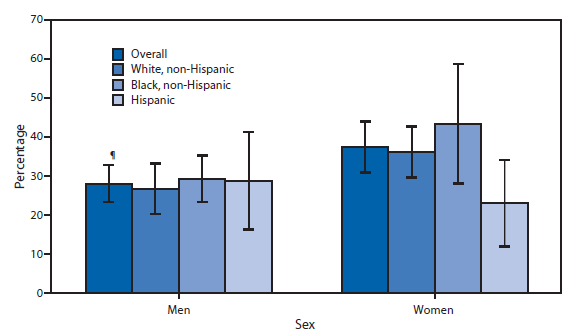Persons using assistive technology might not be able to fully access information in this file. For assistance, please send e-mail to: mmwrq@cdc.gov. Type 508 Accommodation and the title of the report in the subject line of e-mail.
QuickStats: Percentage of Adults with Hypertension* Who Monitored Their Blood Pressure at Home at Least Once a Month,† by Sex and Race/Ethnicity — National Health and Nutrition Examination Survey, United States, 2009–2010§

* Hypertension was defined as systolic blood pressure ≥140 mm Hg, diastolic blood pressure ≥90 mm Hg, or currently taking medication to lower blood pressure, based on affirmative responses to the following questions: "Have you ever been told by a doctor or other health professional that you had hypertension, also called high blood pressure?"; "Because of your [high blood pressure/hypertension], have you ever been told to take prescribed medicine?"; and "Are you now taking a prescribed medicine?"
† Data on home blood pressure monitoring come from two questions. Respondents were first asked, "Did you take your blood pressure at home during the last 12 months?" Respondents who answered "yes" were then asked, "How often did you check your blood pressure at home during the last 12 months?"
§ All estimates are age-adjusted to the 2000 projected U.S. standard population using the age groups 18–39, 40–59, and ≥60 years.
¶ 95% confidence interval.
During 2009–2010, approximately 32% of adults aged ≥18 years with hypertension reported that they monitored their blood pressure at home at least once a month. Women with hypertension were more likely to monitor their blood pressure than men with hypertension (37% versus 28%). Non-Hispanic black women with hypertension were more likely to monitor their blood pressure at home than Hispanic women with hypertension. No differences were observed by race or Hispanic ethnicity among men.
Source: Ostchega Y, Berman L, Hughes JP, Chen TC, Chiappa MM. Home blood pressure monitoring and hypertension status among US adults: the National Health and Nutrition Examination Survey (NHANES), 2009–2010. Am J Hypertens 2013;26:1086–92.
Reported by: Yechiam Ostchega, PhD, yxo1@cdc.gov, 301-458-4408; Steven M. Frenk, PhD.
Alternate Text: The figure above shows the percentage of adults with hypertension who monitored their blood pressure at home at least once a month, by sex and race/ethnicity, in the United States during 2009-2010. During that period, approximately 32% of adults aged ≥18 years with hypertension reported that they monitored their blood pressure at home at least once a month. Women with hypertension were more likely to monitor their blood pressure than men with hypertension (37% versus 28%). Non-Hispanic black women with hypertension were more likely to monitor their blood pressure at home than Hispanic women with hypertension. No differences were observed by race or Hispanic ethnicity among men.
Use of trade names and commercial sources is for identification only and does not imply endorsement by the U.S. Department of
Health and Human Services.
References to non-CDC sites on the Internet are
provided as a service to MMWR readers and do not constitute or imply
endorsement of these organizations or their programs by CDC or the U.S.
Department of Health and Human Services. CDC is not responsible for the content
of pages found at these sites. URL addresses listed in MMWR were current as of
the date of publication.
All MMWR HTML versions of articles are electronic conversions from typeset documents.
This conversion might result in character translation or format errors in the HTML version.
Users are referred to the electronic PDF version (http://www.cdc.gov/mmwr)
and/or the original MMWR paper copy for printable versions of official text, figures, and tables.
An original paper copy of this issue can be obtained from the Superintendent of Documents, U.S.
Government Printing Office (GPO), Washington, DC 20402-9371;
telephone: (202) 512-1800. Contact GPO for current prices.
**Questions or messages regarding errors in formatting should be addressed to
mmwrq@cdc.gov.
 ShareCompartir
ShareCompartir


